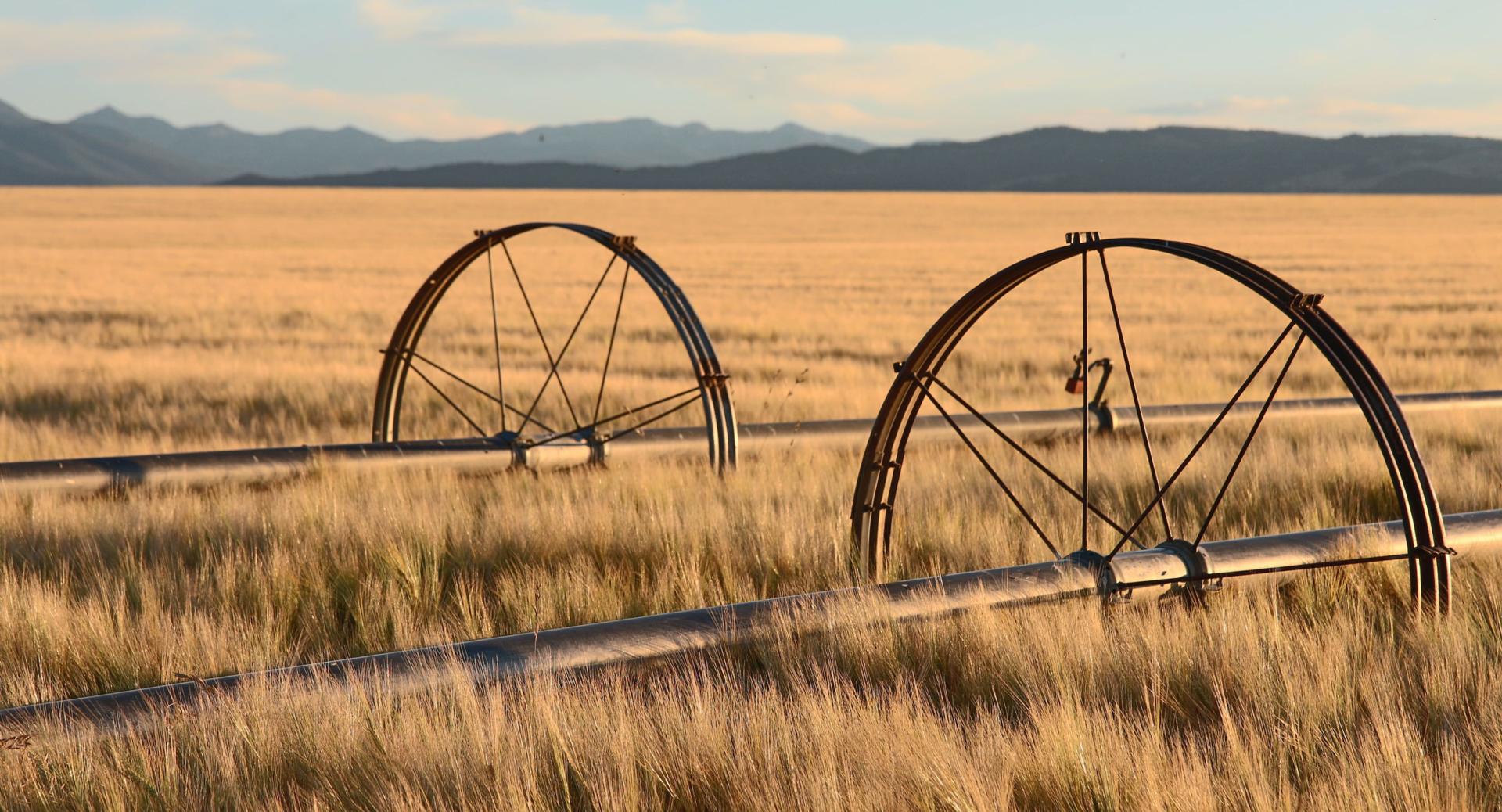Agriculture
Drought can reduce both water availability and water quality necessary for productive farms, ranches, and grazing lands, resulting in significant negative direct and indirect economic impacts to the agricultural sector. Drought can also contribute to insect outbreaks, increases in wildfire and altered rates of carbon, nutrient, and water cycling—all of which can impact agricultural production, critical ecosystem functions that underpin agricultural systems, and the livelihoods and health of farming communities.
The U.S. Department of Agriculture's (USDA's) National Agricultural Statistics Service (NASS) conducts hundreds of surveys each year and a Census of Agriculture every 5 years. NASS prepares reports covering virtually every aspect of U.S. agriculture, including agricultural commodities statistics for crops and livestock.
This map displays USDA corn crop production (data from 2017) alongside current U.S. Drought Monitor (USDM) drought designations. Learn more.
This map displays USDA soybean crop production (data from 2017) alongside current U.S. Drought Monitor (USDM) drought designations. Learn more.
This map displays USDA hay crop production (data from 2017) alongside current U.S. Drought Monitor (USDM) drought designations. Learn more.
This map displays USDA beef cattle data (from 2017) alongside current U.S. Drought Monitor (USDM) drought designations. Learn more.
This map displays USDA wheat crop production (data from 2017) alongside current U.S. Drought Monitor (USDM) drought designations. Learn more.
Drought can reduce the water availability and water quality necessary for productive farms, ranches, and grazing lands, resulting in significant negative direct and indirect economic impacts to the agricultural sector. Monitoring agricultural drought typically focuses on examining levels of precipitation, evaporative demand, soil moisture, and surface/groundwater quantity and quality.
Learn MoreWater is used in many manufacturing processes. During drought conditions, reductions in or interruption of the water supply can result in a reduction of plant productivity or even closure of manufacturing facilities. Integrating drought and extreme weather events into routine business planning can allow manufacturers and communities to proactively prepare for drought.
Learn MoreDrought can reduce the water availability and water quality necessary for productive farms, ranches, and grazing lands, resulting in significant negative direct and indirect economic impacts to the agricultural sector. Monitoring agricultural drought typically focuses on examining levels of precipitation, evaporative demand, soil moisture, and surface/groundwater quantity and quality.
Learn MoreWater is used in many manufacturing processes. During drought conditions, reductions in or interruption of the water supply can result in a reduction of plant productivity or even closure of manufacturing facilities. Integrating drought and extreme weather events into routine business planning can allow manufacturers and communities to proactively prepare for drought.
Learn MoreDrought can reduce the water availability and water quality necessary for productive farms, ranches, and grazing lands, resulting in significant negative direct and indirect economic impacts to the agricultural sector. Monitoring agricultural drought typically focuses on examining levels of precipitation, evaporative demand, soil moisture, and surface/groundwater quantity and quality.
Learn MoreWater is used in many manufacturing processes. During drought conditions, reductions in or interruption of the water supply can result in a reduction of plant productivity or even closure of manufacturing facilities. Integrating drought and extreme weather events into routine business planning can allow manufacturers and communities to proactively prepare for drought.
Learn MoreDrought can reduce the water availability and water quality necessary for productive farms, ranches, and grazing lands, resulting in significant negative direct and indirect economic impacts to the agricultural sector. Monitoring agricultural drought typically focuses on examining levels of precipitation, evaporative demand, soil moisture, and surface/groundwater quantity and quality.
Learn MoreWater is used in many manufacturing processes. During drought conditions, reductions in or interruption of the water supply can result in a reduction of plant productivity or even closure of manufacturing facilities. Integrating drought and extreme weather events into routine business planning can allow manufacturers and communities to proactively prepare for drought.
Learn MoreDrought can reduce the water availability and water quality necessary for productive farms, ranches, and grazing lands, resulting in significant negative direct and indirect economic impacts to the agricultural sector. Monitoring agricultural drought typically focuses on examining levels of precipitation, evaporative demand, soil moisture, and surface/groundwater quantity and quality.
Learn MoreWater is used in many manufacturing processes. During drought conditions, reductions in or interruption of the water supply can result in a reduction of plant productivity or even closure of manufacturing facilities. Integrating drought and extreme weather events into routine business planning can allow manufacturers and communities to proactively prepare for drought.
Learn MoreCorn Produced by County
U.S. Drought Monitor
D0 - Abnormally Dry
Abnormally Dry (D0) indicates a region that is going into or coming out of drought, according to the U.S. Drought Monitor. View typical impacts by state.
D1 – Moderate Drought
Moderate Drought (D1) is the first of four drought categories (D1–D4), according to the U.S. Drought Monitor. View typical impacts by state.
D2 – Severe Drought
Severe Drought (D2) is the second of four drought categories (D1–D4), according to the U.S. Drought Monitor. View typical impacts by state.
D3 – Extreme Drought
Extreme Drought (D3) is the third of four drought categories (D1–D4), according to the U.S. Drought Monitor. View typical impacts by state.
D4 – Exceptional Drought
Exceptional Drought (D4) is the most intense drought category, according to the U.S. Drought Monitor. View typical impacts by state.
Soybeans Produced by County
U.S. Drought Monitor
D0 - Abnormally Dry
Abnormally Dry (D0) indicates a region that is going into or coming out of drought, according to the U.S. Drought Monitor. View typical impacts by state.
D1 – Moderate Drought
Moderate Drought (D1) is the first of four drought categories (D1–D4), according to the U.S. Drought Monitor. View typical impacts by state.
D2 – Severe Drought
Severe Drought (D2) is the second of four drought categories (D1–D4), according to the U.S. Drought Monitor. View typical impacts by state.
D3 – Extreme Drought
Extreme Drought (D3) is the third of four drought categories (D1–D4), according to the U.S. Drought Monitor. View typical impacts by state.
D4 – Exceptional Drought
Exceptional Drought (D4) is the most intense drought category, according to the U.S. Drought Monitor. View typical impacts by state.
Hay Produced by County
U.S. Drought Monitor
D0 - Abnormally Dry
Abnormally Dry (D0) indicates a region that is going into or coming out of drought, according to the U.S. Drought Monitor. View typical impacts by state.
D1 – Moderate Drought
Moderate Drought (D1) is the first of four drought categories (D1–D4), according to the U.S. Drought Monitor. View typical impacts by state.
D2 – Severe Drought
Severe Drought (D2) is the second of four drought categories (D1–D4), according to the U.S. Drought Monitor. View typical impacts by state.
D3 – Extreme Drought
Extreme Drought (D3) is the third of four drought categories (D1–D4), according to the U.S. Drought Monitor. View typical impacts by state.
D4 – Exceptional Drought
Exceptional Drought (D4) is the most intense drought category, according to the U.S. Drought Monitor. View typical impacts by state.
Cattle Produced by County
U.S. Drought Monitor
D0 - Abnormally Dry
Abnormally Dry (D0) indicates a region that is going into or coming out of drought, according to the U.S. Drought Monitor. View typical impacts by state.
D1 – Moderate Drought
Moderate Drought (D1) is the first of four drought categories (D1–D4), according to the U.S. Drought Monitor. View typical impacts by state.
D2 – Severe Drought
Severe Drought (D2) is the second of four drought categories (D1–D4), according to the U.S. Drought Monitor. View typical impacts by state.
D3 – Extreme Drought
Extreme Drought (D3) is the third of four drought categories (D1–D4), according to the U.S. Drought Monitor. View typical impacts by state.
D4 – Exceptional Drought
Exceptional Drought (D4) is the most intense drought category, according to the U.S. Drought Monitor. View typical impacts by state.
Wheat Produced by County
U.S. Drought Monitor
D0 - Abnormally Dry
Abnormally Dry (D0) indicates a region that is going into or coming out of drought, according to the U.S. Drought Monitor. View typical impacts by state.
D1 – Moderate Drought
Moderate Drought (D1) is the first of four drought categories (D1–D4), according to the U.S. Drought Monitor. View typical impacts by state.
D2 – Severe Drought
Severe Drought (D2) is the second of four drought categories (D1–D4), according to the U.S. Drought Monitor. View typical impacts by state.
D3 – Extreme Drought
Extreme Drought (D3) is the third of four drought categories (D1–D4), according to the U.S. Drought Monitor. View typical impacts by state.
D4 – Exceptional Drought
Exceptional Drought (D4) is the most intense drought category, according to the U.S. Drought Monitor. View typical impacts by state.
The U.S. Department of Agriculture's (USDA's) National Agricultural Statistics Service (NASS) conducts hundreds of surveys each year and a Census of Agriculture every 5 years. NASS prepares reports covering virtually every aspect of U.S. agriculture, including agricultural commodities statistics for crops and livestock.
This map displays USDA corn crop production (data from 2017) alongside current U.S. Drought Monitor (USDM) drought designations. Learn more.
This map displays USDA soybean crop production (data from 2017) alongside current U.S. Drought Monitor (USDM) drought designations. Learn more.
This map displays USDA hay crop production (data from 2017) alongside current U.S. Drought Monitor (USDM) drought designations. Learn more.
This map displays USDA beef cattle data (from 2017) alongside current U.S. Drought Monitor (USDM) drought designations. Learn more.
This map displays USDA wheat crop production (data from 2017) alongside current U.S. Drought Monitor (USDM) drought designations. Learn more.
Drought can reduce the water availability and water quality necessary for productive farms, ranches, and grazing lands, resulting in significant negative direct and indirect economic impacts to the agricultural sector. Monitoring agricultural drought typically focuses on examining levels of precipitation, evaporative demand, soil moisture, and surface/groundwater quantity and quality.
Learn MoreWater is used in many manufacturing processes. During drought conditions, reductions in or interruption of the water supply can result in a reduction of plant productivity or even closure of manufacturing facilities. Integrating drought and extreme weather events into routine business planning can allow manufacturers and communities to proactively prepare for drought.
Learn MoreDrought can reduce the water availability and water quality necessary for productive farms, ranches, and grazing lands, resulting in significant negative direct and indirect economic impacts to the agricultural sector. Monitoring agricultural drought typically focuses on examining levels of precipitation, evaporative demand, soil moisture, and surface/groundwater quantity and quality.
Learn MoreWater is used in many manufacturing processes. During drought conditions, reductions in or interruption of the water supply can result in a reduction of plant productivity or even closure of manufacturing facilities. Integrating drought and extreme weather events into routine business planning can allow manufacturers and communities to proactively prepare for drought.
Learn MoreDrought can reduce the water availability and water quality necessary for productive farms, ranches, and grazing lands, resulting in significant negative direct and indirect economic impacts to the agricultural sector. Monitoring agricultural drought typically focuses on examining levels of precipitation, evaporative demand, soil moisture, and surface/groundwater quantity and quality.
Learn MoreWater is used in many manufacturing processes. During drought conditions, reductions in or interruption of the water supply can result in a reduction of plant productivity or even closure of manufacturing facilities. Integrating drought and extreme weather events into routine business planning can allow manufacturers and communities to proactively prepare for drought.
Learn MoreDrought can reduce the water availability and water quality necessary for productive farms, ranches, and grazing lands, resulting in significant negative direct and indirect economic impacts to the agricultural sector. Monitoring agricultural drought typically focuses on examining levels of precipitation, evaporative demand, soil moisture, and surface/groundwater quantity and quality.
Learn MoreWater is used in many manufacturing processes. During drought conditions, reductions in or interruption of the water supply can result in a reduction of plant productivity or even closure of manufacturing facilities. Integrating drought and extreme weather events into routine business planning can allow manufacturers and communities to proactively prepare for drought.
Learn MoreDrought can reduce the water availability and water quality necessary for productive farms, ranches, and grazing lands, resulting in significant negative direct and indirect economic impacts to the agricultural sector. Monitoring agricultural drought typically focuses on examining levels of precipitation, evaporative demand, soil moisture, and surface/groundwater quantity and quality.
Learn MoreWater is used in many manufacturing processes. During drought conditions, reductions in or interruption of the water supply can result in a reduction of plant productivity or even closure of manufacturing facilities. Integrating drought and extreme weather events into routine business planning can allow manufacturers and communities to proactively prepare for drought.
Learn MoreAgricultural Production Losses
The primary direct economic impact of drought in the agricultural sector is crop failure and pasture losses. These costs are often passed on to consumers through increased prices and/or they may be offset through government disaster assistance programs. Indirect impacts of drought in the sector can include reduced supplies to downstream industries, such as food processors, and reduced demand for inputs, such as fertilizer and farm labor. The non-market impacts of production losses include mental health strain on farmers.
Decreased Water Availability for Agriculture
The depletion of water availability in soils causes significant declines in crops and livestock productivity. In addition, surface and groundwater supplies may decline during drought, affecting water availability and increasing costs to access water for crop or forage irrigation and watering livestock. With a return to normal precipitation, soil moisture typically recovers long before surface and groundwater supplies are replenished.
Pests and Diseases
Drought, coupled with high temperatures, may expand the distribution and incidence of pests and diseases that affect crops, forage, and livestock.
Specialty Crops
Most specialty crops (such as fruits, vegetables, tree nuts, and medicinal herbs) are more vulnerable to drought than field crops and have a higher value per unit of land/water. They may therefore represent a higher risk for experiencing economic loss in drought if the crop water demand exceeds water supply.
Drought Impacts on Agriculture
The agricultural sector is an important contributor to the economy of the United States in many ways, from promoting food and energy security to providing jobs in rural communities. In 2015, farms contributed $136.7 billion to the U.S. economy and accounted for 2.6 million jobs, with about half of farm revenue coming from livestock production. Other agriculture- and food-related sectors contributed an additional $855 billion and accounted for 21 million full- and part-time jobs.
Drought ranks third among environmental phenomena associated with billion-dollar weather disasters since 1980, behind tropical cyclones and severe storms. The cost of drought events averages over $9 billion per year, with an annual cost of over $6 billion, making it a serious hazard with substantial socioeconomic consequences.
Sustained drought has considerable negative effects on crops and livestock, including the reduced production, destruction of property, and livestock sell-offs.
For example, in 2012, severe drought impacted 80 percent of agricultural land in the United States, causing more than two-thirds of its counties to be declared disaster areas. The drought affected the production of livestock and field crops such as wheat, corn, and soybean production in the Great Plains and Midwest and accounted for $14.5 billion in loss payments by the federal crop insurance program. In 2015, drought impacts to California’s agricultural sector resulted in $1.84 billion in direct costs, a loss of 10,100 seasonal jobs, and surface water shortages of 8.7 million acre-feet.
NIDIS partners with the USDA Climate Hubs across the nation to support agricultural producers and ranchers with early information of drought onset and intensification; assessing the impacts of drought on the sector and the economy; and training and raising awareness among farmers and ranchers of how drought is depicted in the U.S. Drought Monitor, which determines federal assistance for producers.
Drought Early Warning for the Agriculture Sector
Agricultural production is affected by climate and weather variability. Drought early warning systems are vital for the agricultural sector to prepare for this variability, strengthening its resilience to drought.
The resources below are organized by the key components of a drought early warning system: (1) drought observation and monitoring; (2) drought planning and preparedness; (3) prediction and forecasting of drought; (4) communication and outreach to the public and affected sectors; and (5) interdisciplinary and applied research on topics of concern to drought-affected sectors.
Observation & Monitoring

Planning & Preparedness

Prediction & Forecasting

Communication & Outreach

Interdisciplinary Research & Applications


Related Content
Data & Maps | Agriculture
This collection ranges from easy-to-understand maps depicting drought severity to experimental, satellite-based composite maps primarily used by climate monitoring professionals.
Drought Relief, Recovery, and Support
A number of federal and state agencies provide relief and recovery support for drought impacts. Find more resources here.
Research & Learn | Flash Drought
Flash droughts can cause extensive damage to agriculture and economies if they are not predicted and discovered early. Learn more about flash drought here.
Research & Learn | Monitoring Drought
Drought monitoring involves measuring changes in precipitation, temperature, and surface and groundwater supplies, among other factors. Learn more about the importance of monitoring drought.

